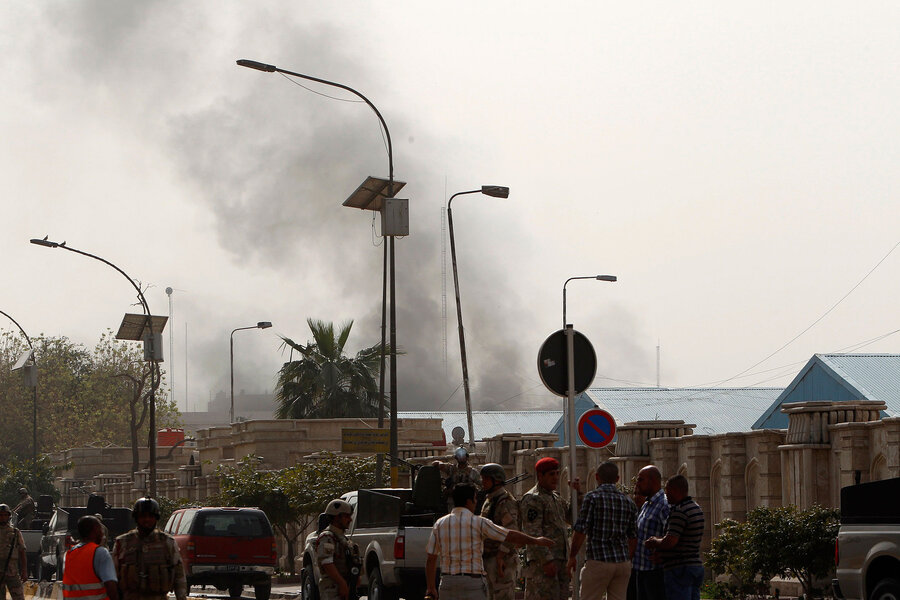Iraq attack shows coordination, planning, and numbers
Loading...
The clocks are ticking down to the tenth anniversary of the US-led invasion and occupation of Iraq. Forums and roundtables are convening to look back at all the spending and the death and trying to put a bow around what it means and what we've learned from the fiasco.
Back in Iraq of course, the war never really ended, as a highly sophisticated series of attacks that claimed over 25 lives in downtown Baghdad today demonstrated.
Though Iraq is much more peaceful than it was during the height of its sectarian civil war from 2003 to 2009, which claimed more than 165,000 lives, it remains one of the world's most dangerous places. In 2011 it suffered more terrorist attacks and deaths from terrorist attacks than any other country but Afghanistan.
When the numbers are counted for 2012, it is unlikely that Iraq's rankings will have improved much. All indications going back into early 2012 have been of rising sectarian violence, and more effective use of terror tactics by Sunni militants.
Thursday's events in Baghdad, a complex, well-coordinated attack on the government in the heart of the capital, are in some ways a culmination of that rising trend. The Shiite-dominated government of Prime Minister Nouri al-Maliki has sidelined Sunni political rivals, when it hasn’t pursued politically-motivated terrorism investigations against them.
In Sunni majority areas like Anbar Province, running west from Baghdad along the Euphrates, the grievances that have simmered since the US departure from Iraq have come close to boiling again.
What that means is not only more recruits for Sunni militant groups, but also a greater willingness of Sunnis not directly involved to look the other way when they stumble across a neighbor preparing a suicide car bomb in his garage.
That Iraqi unity and “reconciliation” that the US troop surge was supposed to set the stage for in the country? That never happened.
Helped by the sectarian war across the border in Syria, Jihadi groups like the Islamic State in Iraq (ISI), which has links to Al Qaeda, have been on the upswing recently. There has been no claim of responsibility for today’s attacks, but it would make sense for the ISI to have carried it out.
They’re certainly capable; earlier this month the ISI killed 46 Syrian government troops, taking a breather from fighting the largely Sunni uprising at home in Iraq. Iraq’s Sunni militants and Syria’s have many causes and goals in common, while Maliki is viewed as aligned with Bashar al-Assad’s Shiite patron, Iran. A victory for the rebels in Syria could prove a major boost for militants in Iraq.
They’re already doing alright. At about 1 p.m. Baghdad time Thursday, a suicide bomber detonated himself in the lobby of the Justice Ministry, which is huddled behind layers of security checkpoints and fencing, killing bystanders, and setting off panic. Three comrades of his, armed with rifles, then stormed the building and exchanged fire with police before being killed themselves. Then, another car bomb targeted this area.
At roughly the same time in another part of town, a suicide car bomber targeted an Interior Ministry facility.
These are exactly the type of tactics that became so common during the height of America’s involvement in the war, and the perpetrators are likely to be the same kind of people that US spokesmen were so found of calling “dead-enders.” These attacks require planning, operational security, and coordination.
Iraq’s Sunnis have gotten the short end of the stick from Maliki, who is theoretically the head of a "power-sharing" government designed to address sectarian grievances, but in practice has been running the country by fiat since the US departure from Iraq at the end of 2011. A growing protest movement among the Sunni population, particularly in Anbar, where the fiercest engagements of the US war in Iraq were fought, has been volatile. In January, government troops killed five protesters in Fallujah, the town that US infantry and Marines tried to “pacify,” twice.
If Maliki isn’t careful, the war that never really ended could get a lot worse.








